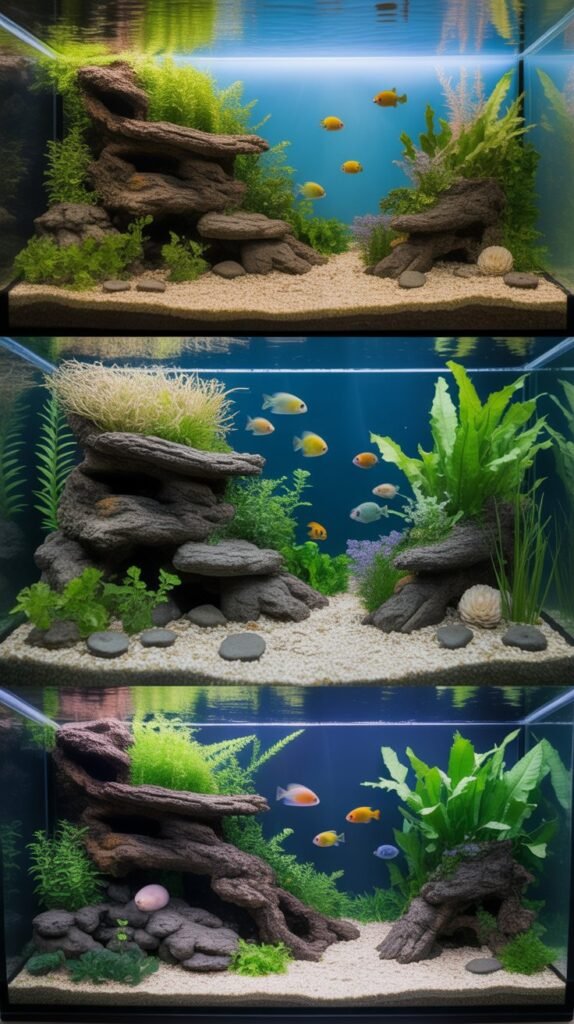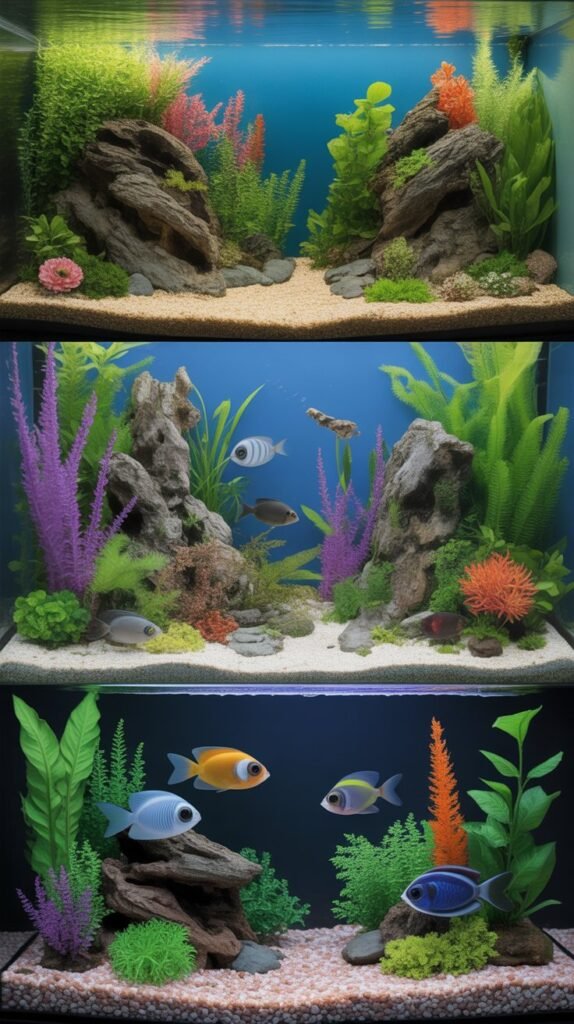When setting up a fish tank, most aquarists focus on essentials like filtration, heating, substrate, and decorations. However, one often overlooked yet crucial element is the aquarium lid. Also known as a tank cover or hood, an aquarium lid serves multiple functions: it keeps fish from jumping out, reduces evaporation, prevents debris from entering the water, and provides a surface for mounting lighting systems.
But beyond its functional benefits, an aquarium lid can also enhance the overall look of your tank. With a little creativity, aquarists can transform a simple lid into a stylish, practical, and unique feature. In this guide, we’ll explore the best aquarium lid ideas, materials, DIY solutions, and maintenance tips to help you choose the perfect cover for your setup.
Why Do You Need an Aquarium Lid?
Before diving into design ideas, it’s important to understand why aquarium lids are essential:
- Prevents fish from jumping out: Species like bettas, guppies, and arowanas are known escape artists.
- Reduces evaporation: Lids minimize water loss, keeping parameters stable.
- Keeps contaminants out: Protects water from dust, dirt, and pet hair.
- Provides a lighting mount: Many lids hold built-in or external lights.
- Improves safety: Protects pets, children, and household items from accidental contact with water.
- Enhances aesthetics: A well-designed lid gives your tank a polished, professional look.
Popular Aquarium Lid Ideas

Here are some creative and functional aquarium lid ideas that aquarists can use:
1. Glass Aquarium Lid
A classic choice, glass lids are sleek, durable, and provide clear visibility. They are perfect for tanks with strong lighting systems since glass does not warp from heat.
- Pros: Easy to clean, transparent, long-lasting.
- Cons: Can be heavy and fragile.
2. Acrylic Aquarium Lid
Lightweight and shatter-resistant, acrylic lids are a versatile option. They can be cut into different shapes, making them great for custom aquariums.
- Pros: Lightweight, customizable, durable.
- Cons: Prone to scratches if not handled carefully.
3. Mesh Aquarium Lid
Mesh lids are ideal for saltwater aquariums, especially reef tanks. They allow excellent airflow and prevent fish from escaping without trapping heat.
- Pros: Great ventilation, lightweight, customizable.
- Cons: Limited protection against evaporation and dust.
4. Sliding Panel Lid
Lids with sliding glass or acrylic panels are convenient for daily feeding and maintenance. They’re practical for aquarists who frequently interact with their tanks.
- Pros: Easy access, neat design.
- Cons: May trap moisture if not ventilated.
5. DIY Wooden Lid
For aquarists who want a natural or furniture-style look, wooden lids are a popular DIY project. They can be stained, painted, or matched with aquarium stands.
- Pros: Stylish, customizable, matches home décor.
- Cons: Requires sealing to resist water damage.
6. Hinged Aquarium Lid
A hinged lid makes cleaning and feeding simple. These lids can be made from glass, acrylic, or wood with a flip-up design.
- Pros: User-friendly, durable.
- Cons: Hinges may rust if not maintained.
7. Floating Glass Lid
Some modern aquariums use minimalistic floating glass lids that sit slightly below the tank rim. They look sleek and keep evaporation in check while giving the aquarium an open feel.
- Pros: Elegant design, minimalist look.
- Cons: Provides less protection from dust.
8. Decorative Aquarium Lid
Creative aquarists sometimes design lids that double as decorative elements. For example, a lid with carved wood patterns, frosted glass designs, or even LED accents.
- Pros: Enhances aesthetics, unique.
- Cons: More expensive or time-consuming to create.
9. Metal Frame Lid
Sturdy metal frames with mesh or acrylic panels are great for large aquariums. They provide strength and durability while allowing ventilation.
- Pros: Long-lasting, strong.
- Cons: Heavier and more industrial-looking.
10. Open-Top with Rim Frame
For aquarists who love an open-top aquarium but want fish protection, a rimmed mesh frame lid is a perfect balance. It keeps fish inside while maintaining an airy, modern design.
- Pros: Stylish, breathable.
- Cons: Doesn’t prevent evaporation.
DIY Aquarium Lid Ideas

Building your own aquarium lid is a great way to save money and customize the design. Here are some DIY ideas:
1. Acrylic Sheet with Cutouts
Purchase an acrylic sheet, cut it to size, and add cutouts for filters and feeding holes. Attach hinges for easy access.
2. Wooden Frame with Mesh
Build a lightweight wooden frame and attach fine mesh or netting. This is perfect for reef aquariums that require strong airflow.
3. Repurposed Furniture Wood
Use reclaimed wood or furniture parts to create a rustic-looking aquarium lid. Stain or paint it to match your aquarium stand.
4. PVC Frame with Netting
For large tanks, a PVC frame with mesh offers a cheap, durable, and easy-to-build solution.
5. Floating Glass Panels
Cut tempered glass panels slightly smaller than the tank’s opening. Place them on transparent rubber supports to create a floating lid effect.
Choosing the Right Aquarium Lid
When selecting an aquarium lid, consider the following factors:
- Tank Size: Larger tanks require stronger, more durable lids.
- Type of Fish: Jumping species like bettas and guppies require secure lids.
- Aquarium Type: Reef tanks benefit from mesh lids, while planted tanks may prefer glass or acrylic.
- Lighting System: Ensure the lid can support or allow light penetration.
- Budget: Lids range from budget-friendly DIY solutions to premium custom covers.
- Maintenance Access: Look for lids with hinges, sliding panels, or feeding holes.
Aquarium Lid Design Tips
- Ventilation is Key – Always include holes or vents to allow gas exchange and prevent heat buildup.
- Easy Access – Ensure you can feed fish and clean the tank without removing the entire lid.
- Stylish Integration – Match your lid with your aquarium stand and room décor.
- Durability First – Choose materials resistant to warping, rust, or water damage.
- Safety Considerations – Avoid materials that can leach harmful chemicals into the water.
Pros and Cons of Aquarium Lids
Pros:
- Prevents fish from escaping.
- Reduces water evaporation.
- Protects tank from dust and debris.
- Provides mounting surface for lights.
- Enhances the look of the tank.
Cons:
- May trap heat if poorly ventilated.
- Can make maintenance slightly harder.
- Wooden lids require waterproofing.
- Glass lids can be heavy and fragile.
Aquarium Lid vs. Aquarium Canopy

While both terms are often used interchangeably, there is a difference:
- Aquarium Lid: A simple cover made from glass, acrylic, mesh, or wood. Its main function is protection and practicality.
- Aquarium Canopy: A larger decorative structure, often with built-in lights, that sits on top of the tank like a piece of furniture.
Maintenance Tips for Aquarium Lids
- Clean Regularly: Wipe away condensation, algae, and dust.
- Check Hinges: Oil or replace rusty hinges to keep lids functional.
- Inspect Cutouts: Ensure filter and feeder holes remain unclogged.
- Polish Acrylic: Use acrylic-safe cleaners to remove scratches.
- Re-seal Wooden Lids: Apply waterproof coatings every few months.
FAQs About Aquarium Lid Ideas
1. What is the best aquarium lid for beginners?
A glass or acrylic lid is the best choice for beginners due to durability and ease of cleaning.
2. Do I really need an aquarium lid?
Yes. While some aquarists run open tanks, lids help prevent fish from escaping, reduce evaporation, and keep contaminants out.
3. Which is better, glass or acrylic lids?
Glass lids are scratch-resistant and long-lasting, while acrylic lids are lightweight and customizable.
4. Can I make my own aquarium lid?
Absolutely! Many aquarists build DIY lids from acrylic, wood, mesh, or glass to suit their needs.
5. Are mesh lids good for planted tanks?
Mesh lids allow ventilation but reduce humidity, which can dry out certain plants. They are better for reef tanks.
6. How do I stop condensation on my lid?
Ensure proper ventilation, install fans if necessary, and clean the lid regularly.
7. Do aquarium lids affect lighting?
Yes. Glass and acrylic lids may slightly reduce light penetration, but modern LED systems usually compensate for this.
8. Can wooden lids damage my aquarium?
Not if sealed properly. Always use waterproof sealants to prevent warping and contamination.
9. How often should I clean my aquarium lid?
At least once a week, or whenever you notice buildup of algae, condensation, or dust.
10. Where can I buy aquarium lids?
You can buy aquarium lids online, at pet stores, or have custom ones made by aquarium manufacturers.
Conclusion
When it comes to aquariums, the lid is more than just a cover – it’s an essential part of your setup that impacts safety, maintenance, and aesthetics. With so many aquarium lid ideas available, from sleek glass designs to creative DIY wooden covers, you can choose a solution that suits your aquarium type, fish species, and home décor.
Whether you opt for a minimalist floating lid, a sturdy mesh frame, or a decorative custom design, the right lid will not only protect your fish but also elevate the look of your aquarium.

